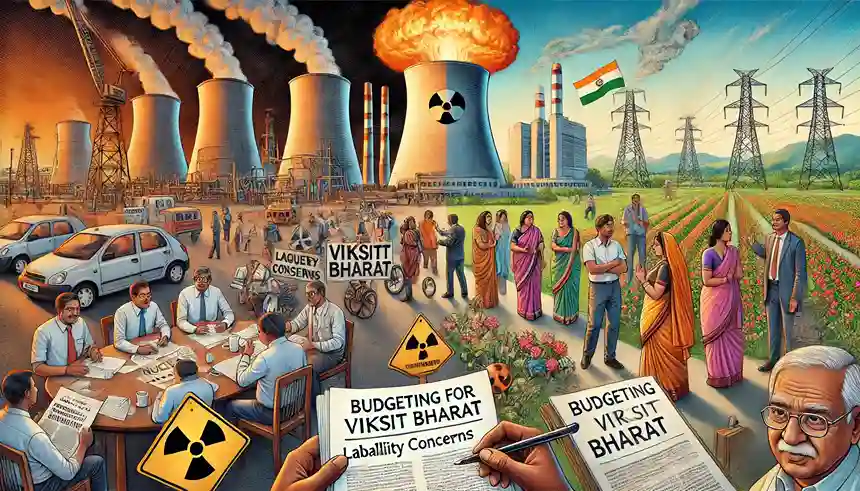Analysis of Indian Express Editorial 1: As the World Warms and Cools
Context
As the World Warms and Cools: Why Climate Change is a National Security Issue
Introduction: The Rising Threat of Climate Change
Climate change has far-reaching consequences, not only for the environment but also for national security. As the world continues to face frequent and severe natural disasters, economies suffer, and the stability of nations is put at risk. Understanding the interconnectedness of climate change, economic downturns, and national security is essential in formulating policies that safeguard both people and economies.
Disasters and Economic Instability
Natural disasters strike various parts of the world year-round, and the economic damage they cause can derail even the most ambitious national goals. For India, which aims to become a $5-trillion economy and later achieve the $10-trillion mark, frequent disasters pose a significant challenge. They not only cause immediate economic losses but also create long-term economic downturns. More critically, these disasters represent a direct threat to national security.
When livelihoods are destroyed, communities become more vulnerable. This vulnerability is often exploited by those with radical ideologies, leading to social unrest, migration crises, and even increased illegal activities. Therefore, addressing disaster management and risk reduction is more than just a humanitarian effort; it is an integral part of maintaining a stable and secure nation.
- Analysis of The Hindu Editorial – February 13, 2025

- Analysis of The Hindu Editorial – February 12, 2025

- Analysis of The Hindu Editorial – January 1, 2025

- Analysis of The Hindu Editorial – December 31, 2024

- Analysis of The Hindu Editorial – December 19, 2024

Disaster Risk Insurance: A Critical Need
In response to the growing need for better disaster management, the concept of disaster risk insurance is gaining traction globally. At the 2016 Asian Ministerial Conference on Disaster Risk Reduction (DRR), Indian Prime Minister Narendra Modi introduced a ten-point agenda for DRR, with a key focus on expanding risk coverage. This coverage must encompass everyone, from small households to multinational corporations, ensuring that the most vulnerable are not left behind.
Why Disaster Risk Insurance is Important
- Physical Protection: Early warning systems, risk mitigation, and swift responses are necessary, but they are not enough. People need the reassurance that, when disaster strikes, they will receive financial support to rebuild their lives.
- Financial Compensation: Governments cannot always provide full compensation to every affected individual, especially in large-scale disasters. Insurance serves as a crucial buffer, allowing individuals and businesses to recover more quickly while easing the financial burden on the state.
- Sustainable Business Models: Global insurance companies have studied the feasibility of disaster risk insurance and found that it can be a viable business model, benefiting both insurers and policyholders.
The Growing Role of Disaster Insurance in India
India is starting to take disaster insurance seriously. Recently, the National Disaster Management Authority (NDMA) conducted a workshop with insurance industry leaders to explore how disaster risk insurance can be tailored to Indian needs. This collaborative approach between the government, insurers, and financial experts offers hope for developing insurance products that serve the interests of all parties involved.
One innovative approach gaining popularity is parametric insurance. Unlike traditional insurance, which requires detailed verification of individual claims, parametric insurance provides immediate payouts based on predefined parameters related to the disaster. For instance, if a certain level of rainfall is recorded, payouts are triggered automatically. This system eliminates lengthy approval processes, ensuring that victims receive aid faster.
Human Security and National Security: A Close Relationship
Human security—the safety and well-being of individuals—is a cornerstone of national security. When disaster strikes, displaced people are often left homeless and desperate, making them vulnerable to exploitation. Historically, such vulnerabilities have led to illegal migration and increased unrest in receiving countries.
For example, following the devastating earthquake in Haiti in 2011, over 300,000 people lost their lives, and many survivors were forced to migrate. The ripple effects of this migration are still felt today, influencing US politics and immigration policies. Similarly, Africa’s frequent droughts have pushed several countries, such as Somalia and Sudan, into prolonged periods of instability and economic debt, further exacerbating societal tensions.
- [PDF] “Arihant Computer Awareness Book 1” – Free Download
![[PDF] Arihant Computer Book.pdf” – Free Download for Competitive Exams](https://savepdf.in/wp-content/uploads/2025/04/PDF-Arihant-Computer-Book.pdf-–-Free-Download-for-Competitive-Exams-1040x650.webp)
- [PDF] The Pragmatic Programmer by David Thomas and Andrew Hunt

- [PDF] Structure and Interpretation of Computer Programs
![[PDF] Structure and Interpretation of Computer Programs](https://savepdf.in/wp-content/uploads/2024/12/PDF-Structure-and-Interpretation-of-Computer-Programs-1157x650.webp)
- [PDF] Computer Fundamentals by Anita Goel – Free Download
![[PDF] Computer Fundamentals by Anita Goel – Free Download](https://savepdf.in/wp-content/uploads/2024/11/Computer-FundameComputer-Fundamentals-by-Anita-GoelComputer-Fundamentals-by-Anita-Goelntals-by-Anita-Goel-1156x650.png)
- [PDF] – Mainframe Systems Programming: An Introduction – Download Now
![Mainframe Systems Programming: An Introduction – [PDF]](https://savepdf.in/wp-content/uploads/2024/10/PDF-–-Mainframe-Systems_20241004_162243_0000-1156x650.webp)
Global Examples of Disasters Impacting Security
Haiti, 2011 Earthquake
In 2011, Haiti experienced a catastrophic earthquake that killed over 300,000 people. The Haitian government’s inability to provide adequate relief led to large-scale migration, creating socio-political challenges for neighboring countries. This event continues to have geopolitical ramifications, particularly in the United States.
Africa’s Persistent Droughts
In Africa, recurring droughts have significantly destabilized nations like Somalia, Sudan, and Western Sahara. The resulting food and water shortages have fueled unrest, migration, and societal breakdown, locking these countries into cycles of debt and poverty.
Pakistan-Afghanistan Refugee Crisis
In 1981, millions of Afghan refugees fled to Pakistan following the Soviet invasion. Many were housed in refugee camps along the border, where radical preachers influenced young refugees. This led to the rise of the Taliban, demonstrating how humanitarian crises can evolve into long-term national security threats.
Conclusion: A Call for Global Focus on Disaster Risk Insurance
As climate change intensifies, nations must rethink their approach to security. The link between human security and national security is clear—countries that cannot protect their people from the impacts of disasters will face greater instability. To mitigate these risks, disaster risk insurance must become a global priority. By providing timely financial support, nations can prevent further displacement, reduce vulnerability to radicalization, and ultimately ensure a more secure and resilient future.
Analysis of Indian Express Editorial 2: The $500 Billion Opportunity
Context
The $500 Billion Opportunity: India’s Path to Electronics Manufacturing Growth
Introduction: India’s $500 Billion Vision for Electronics Manufacturing
India has set its sights on becoming a global hub for electronics manufacturing, with an ambitious target of reaching $500 billion in production by 2030. This vision, announced by Prime Minister Narendra Modi, represents a critical opportunity for economic growth, job creation, and global competitiveness. However, achieving such a monumental goal requires bold reforms, strategic regional planning, and a focus on export-driven growth.
India’s Electronics Manufacturing Target
India’s current manufacturing output, valued at approximately $660 billion in 2023-24, sets the stage for this ambitious leap in electronics production. The proposed $500 billion target for the electronics sector alone is audacious, given that it demands a level of growth sustained by few countries in history. Much of this expansion will need to be driven by exports, making international competitiveness essential for success.
- [PDF] Kiran SSC 10600+ General Awareness Book English
![[PDF] Kiran SSC General Awareness Book English](https://savepdf.in/wp-content/uploads/2024/12/PDF-Kiran-SSC-10600-General-Awareness-Book-English-1156x650.webp)
- [PDF] – Manorama Yearbook 2025: A Comprehensive Guide to Knowledge and Exam Success

- [PDF] Blackbook 25000+ GA English Medium
![[PDF] Blackbook 25000+ GA English Medium](https://savepdf.in/wp-content/uploads/2024/11/PDF-Blackbook-25000-GA-English-Medium-1156x650.webp)
- [PDF] Reasoning Made Easy – Download Now
![[PDF] Reasoning Made Easy](https://savepdf.in/wp-content/uploads/2024/11/Reasoning-Made-Easy-1156x650.webp)
- [PDF] Police Recruitment Challenger – Download Now
![[PDF] Police Recruitment Challenger](https://savepdf.in/wp-content/uploads/2024/11/Police-Recruitment-Challenger-1156x650.webp)
Why Electronics Manufacturing Matters
The importance of achieving this target goes beyond economic numbers. Growth in electronics manufacturing is seen as a key solution to India’s jobs challenge. The sector has the potential to provide millions of jobs, particularly in skilled and semi-skilled categories, directly impacting the country’s workforce and economic health.
Achieving Export Competitiveness
For India to succeed in electronics manufacturing, it must focus on creating competitive regional clusters—areas where production is concentrated and supported by robust infrastructure. These clusters have been key to the success of global electronics hubs, from Silicon Valley to Shenzhen. In India, regions like Sriperumbudur in Tamil Nadu and Noida in Uttar Pradesh have begun to emerge as strong players, accounting for nearly 50% of India’s electronics exports.
However, to truly compete on a global scale, these regions need to be expanded and supported with the right policies and infrastructure. This includes ambitious region-led reforms that create large, globally competitive manufacturing ecosystems.
Key Factors for Building Successful Electronics Manufacturing Clusters
- Size Matters: Building Large Manufacturing ZonesOne of the critical factors for the success of global electronics hubs is their large size, which allows for co-location of suppliers and buyers. This proximity fosters competitiveness within the ecosystem, leading to cost efficiency and higher productivity.
- Shenzhen, for example, spans 2,000 km² and exports around $350 billion annually. In comparison, India’s largest electronics cluster, created under the Electronics Manufacturing Cluster (EMC) scheme, is just 2.5 km²—significantly smaller.
- Larger zones not only support industrial infrastructure but also provide necessary social infrastructure such as worker housing, schools, hospitals, and recreational facilities, making them attractive places to live and work.
- Customized Regulations for Export CompetitivenessWhile size is important, regions must also have the right regulatory environment to thrive. For India’s electronics clusters to succeed, customized regulations that align with global manufacturing norms are essential.
- Labour Laws: To compete globally, India needs more flexible, pro-employment labour laws. This includes longer shifts, competitive overtime rules, and policies that encourage the hiring of women, who form a significant portion of the electronics workforce worldwide.
- Taxation: The current tax structure in India makes it difficult for foreign companies to manage component inventory across borders without tax implications, adding unnecessary complexity to manufacturing. By benchmarking corporate tax and GST rates against global competitors like Vietnam and China, India can attract large multinational players to invest in its electronics sector.
- Devolution of Power to Industrial ParksTo ensure responsive governance, there is a need for decentralization of administrative power to the level of industrial parks. The ability to manage approvals, permissions, and regulations at the local level can speed up decision-making processes and improve efficiency.
- Public-Private Partnerships (PPPs) can play a critical role here, helping to develop world-class infrastructure and “plug-and-play” industrial parks that attract global investors. The success of GIFT City as a financial services hub is a model that can be replicated in electronics manufacturing clusters.
A Comparative Look at Global Manufacturing Hubs
| Region | Size (km²) | Key Exports | Regulatory Features | Impact |
|---|---|---|---|---|
| Shenzhen, China | 2,000 | $350 billion | Flexible labour laws, favourable tax regimes | Major global electronics hub |
| Sriperumbudur, India | 2.5 | Growing | Developing regulatory framework | Promising regional cluster |
| Noida, India | N/A | Growing | Developing regulations and industrial infrastructure | Emerging electronics exporter |
India’s regional clusters have shown promise, but they need significant expansion and policy reform to reach the scale and efficiency of global competitors like Shenzhen. By fostering these regions through bold reforms, India can establish itself as a leader in electronics manufacturing.
Conclusion: Will India Seize the $500 Billion Opportunity?
India’s ambition to achieve $500 billion in electronics manufacturing by 2030 represents a monumental opportunity for economic growth and job creation. However, this goal will remain out of reach without the development of large, globally competitive manufacturing clusters and the adoption of region-specific regulatory reforms.
With the right mix of infrastructure investment, regulatory flexibility, and decentralized governance, India can position itself as a major player in the global electronics market. By doing so, the country can not only meet its ambitious manufacturing target but also secure its place in the future of global trade and industry.

